Recent Event: UK and IRL BrainSense™ technology experience.
15-16 June , 2023, Birmingham, UK.
Medtronic's most recent BrainSense™ technology event took place on 15-16 June 2023 in Birmingham, UK. The event played host to a range of experts in the field who spoke on topics that ranged from An Introduction to Local Field Potentials in Clinical Practice, Using BrainSense™ technology in the Initial Programming of a Parkinsons Patient and The Role of LFPs, Image-Guided Programming and Wearable Technology to Optimise Outcomes for DBS to mention just a few.

Resources
UK BrainSense™ technology
Report of Initial User Experience
UK clinicians were asked to record their experience and opinion of programming with BrainSense™ technology. To learn more about the findings please click on the button below.
BrainSense™ technology
Workflow Tip card
Learn more about the HCP workflow for BrainSense™ technology and download our tip card today providing key information and practical examples.
The Percept™ PC neurostimulator features BrainSense™ technology, designed to capture brain signals (local field potentials, or LFPs) using the implanted DBS lead. These signals can be recorded simultaneously while delivering therapeutic stimulation, inside and outside the clinic.
You can correlate these brain signals with stimulation and events capturing medication, symptoms, or side effects to deliver personalized, data-driven treatment and adjust as patient needs evolve.*
Together with the Percept™ PC neurostimulator, BrainSense™ technology* is the most complete deep brain stimulation (DBS) system with sensing and directionality.
Read about research on brain sensing and BrainSense™ technology in this scientific compendium.
BrainSense™ technology captures brain signals (local field potentials, or LFPs) using the implanted DBS lead. These signals can be recorded simultaneously while delivering therapeutic stimulation, inside and outside the clinic.* Clinicians can also correlate these brain signals with stimulation and patient-captured events such as medication, symptoms, or side effects.
BrainSense™ technology .
See how BrainSense™ technology captures brain signals from a person with Parkinson's disease both during and between visits.
Watch VideoRead Case Studies
Overview
Explore real-world examples that share a clinician’s experience with utilising BrainSense™ technology for patient therapy management.
Case Studies
Read Case Study: BrainSense™ technology: Clinician case study on uncovering suboptimal programming4,5
Read Case Study: BrainSense™ technology: Clinician case study on use of BrainSense™ features*
Related Pages
Product Support
Call UK Technical Services & Mobility Support +44 1923 201 805
Decoding Brain Sensing - Podcast Series
Listen TodayBrief Statement:
See the device manual for detailed information regarding the instructions for use, the implant procedure, indications, contraindications, warnings, precautions, and potential adverse events. For further information, contact your local Medtronic representative and/or consult the Medtronic website at www.medtronic.eu.
For applicable products, consult instructions for use on manuals.medtronic.com. Manuals can be viewed using a current version of any major internet browser. For best results, use Adobe Acrobat® Reader with the browser.
The sensing feature of the Percept™ PC device is intended for use in patients receiving DBS where chronically recorded bioelectric data may provide useful, objective information regarding patient clinical status. Signal may not be present or measurable in all patients.
Fasano A, Gorodetsky C, Paul D, et al. Local Field Potential-Based Programming: A Proof-of-Concept Pilot Study. Neuromodulation. 2021 Aug 18. doi: 10.1111/ner.13520.
Binder T, Lange F, Pozzi N, et al. Feasibility of local field potential-guided programming for deep brain stimulation in Parkinson's disease: A comparison with clinical and neuro-imaging guided approaches in a randomized, controlled pilot trial. Brain Stimul. 2023;16(5):1243-1251. doi:10.1016/j.brs.2023.08.017
Swinnen BEKS, Stam MJ, Buijink AWG, et al.. Employing LFP recording to optimize stimulation location and amplitude in chronic DBS for Parkinson’s disease: A proof-of-concept pilot study. Deep Brain Stimulation. 2023;2:1-5. doi:10.1016/j.jdbs.2023.05.003
Schüpbach W, Rau J, Knudsen K, Volkmann J, Krack P, Timmermann L, et al. Neurostimulation for Parkinson’s disease with early motor complications. EARLYSTIM Study. N Eng J Med. 2013;368:610-226.
Follett KA, Weaver FM, Stern M, et al. Pallidal versus subthalamic deep-brain stimulation for Parkinson’s disease. N Engl J Med. 2010;362(22):2077-91.
